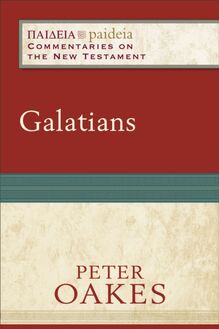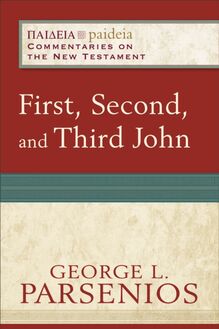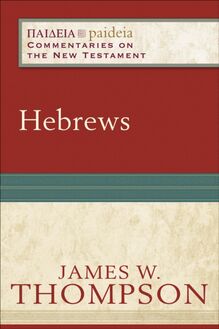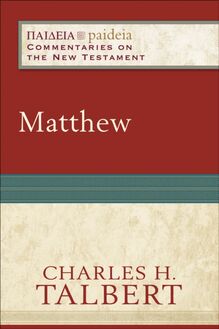-
 Univers
Univers
-
 Ebooks
Ebooks
-
 Livres audio
Livres audio
-
 Presse
Presse
-
 Podcasts
Podcasts
-
 BD
BD
-
 Documents
Documents
-
- Cours
- Révisions
- Ressources pédagogiques
- Sciences de l’éducation
- Manuels scolaires
- Langues
- Travaux de classe
- Annales de BEP
- Etudes supérieures
- Maternelle et primaire
- Fiches de lecture
- Orientation scolaire
- Méthodologie
- Corrigés de devoir
- Annales d’examens et concours
- Annales du bac
- Annales du brevet
- Rapports de stage
La lecture à portée de main
Vous pourrez modifier la taille du texte de cet ouvrage
Découvre YouScribe en t'inscrivant gratuitement
Je m'inscrisEphesians and Colossians (Paideia: Commentaries on the New Testament) , livre ebook
Découvre YouScribe en t'inscrivant gratuitement
Je m'inscrisEn savoir plus
Vous pourrez modifier la taille du texte de cet ouvrage
En savoir plus

Description
Informations
| Publié par | Baker Publishing Group |
| Date de parution | 01 novembre 2007 |
| Nombre de lectures | 0 |
| EAN13 | 9781441206596 |
| Langue | English |
| Poids de l'ouvrage | 1 Mo |
Informations légales : prix de location à la page 0,0864€. Cette information est donnée uniquement à titre indicatif conformément à la législation en vigueur.
Extrait
G ENERAL E DITORS
Mikeal C. Parsons and Charles H. Talbert
A DVISORY B OARD
Paul J. Achtemeier
Loveday Alexander
C. Clifton Black
Susan R. Garrett
Francis J. Moloney
© 2007 by Charles H. Talbert
Published by Baker Academic
a division of Baker Publishing Group
P.O. Box 6287, Grand Rapids, MI 49516–6287
www.bakeracademic.com
Ebook edition created 2013
All rights reserved. No part of this publication may be reproduced, stored in a retrieval system, or transmitted in any form or by any means—for example, electronic, photocopy, recording—without the prior written permission of the publisher. The only exception is brief quotations in printed reviews.
ISBN 978-1-4412-0659-6
Library of Congress Cataloging-in-Publication Data is on file at the Library of Congress, Washington, DC.
Scripture quotations labeled NJB are from THE NEW JERUSALEM BIBLE, copyright © 1985 by Darton, Longman & Todd, Ltd. and Doubleday, a division of Random House, Inc. Reprinted by permission.
Scripture quotations labeled NRSV are from the New Revised Standard Version of the Bible, copyright © 1989, by the Division of Christian Education of the National Council of the Churches of Christ in the United States of America. Used by permission. All rights reserved.
Scripture quotations labeled RSV are from the Revised Standard Version of the Bible, copyright 1952 [2nd edition, 1971] by the Division of Christian Education of the National Council of the Churches of Christ in the United States of America. Used by permission. All rights reserved.
To M. R. Cherry from whom I learned a lot and to whom I owe a lot
Contents
Cover
Series Page
Title Page
Copyright Page
Dedication
List of Figures
Foreword
Preface
Abbreviations
Introduction
Ephesians
Ephesians 1:1–2
Ephesians 1:3–14
Ephesians 1:15–2:10
Ephesians 2:11–22
Ephesians 3:1–21
Ephesians 4:1–16
Ephesians 4:17–5:21
Ephesians 5:22–6:9
Ephesians 6:10–20
Ephesians 6:21–24
Colossians
Colossians 1:1–2
Colossians 1:3–23
Colossians 1:24–2:5
Colossians 2:6–23
Colossians 3:1–4:6
Colossians 4:7–18
Bibliography
Subject Index
Index of Modern Authors
Index of Scripture and Ancient Sources
Notes
List of Figures
1. Map of the Roman Province of Asia
2. Map of Cities of the Province of Asia
3. An Honorific Inscription
4. Paul to the Saints—in Ephesus?
5. The Dual Existence of Believers
6. A Warning to Gentiles
7. An Altar to Peace
8. How to Live in Community
9. Roman Culture in the Lycus Valley
10. The Caves of Qumran
Foreword
Paideia: Commentaries on the New Testament is a series that sets out to comment on the final form of the New Testament text in a way that pays due attention both to the cultural, literary, and theological settings in which the text took form and also to the interests of the contemporary readers to whom the commentaries are addressed. This series is aimed squarely at students—including MA students in religious and theological studies programs, seminarians, and upper-divisional undergraduates— who have theological interests in the biblical text. Thus, the didactic aim of the series is to enable students to understand each book of the New Testament as a literary whole rooted in a particular ancient setting and related to its context within the New Testament.
The name “Paideia” reflects (1) the instructional aim of the series— giving contemporary students a basic grounding in academic NT studies by guiding their engagement with New Testament texts; (2) the fact that the New Testament texts as literary unities are shaped by the educational categories and ideas (rhetorical, narratological, etc.) of their ancient writers and readers; and (3) the pedagogical aims of the texts themselves— their central aim being not simply to impart information but to form the theological convictions and moral habits of their readers.
Each commentary deals with the text in terms of larger rhetorical units; these are not verse-by-verse commentaries. This series thus stands within the stream of recent commentaries that attend to the final form of the text. Such reader-centered literary approaches are inherently more accessible to liberal arts students without extensive linguistic and historical-critical preparation than older exegetical approaches, but within the reader-centered world the sanest practitioners have paid careful attention to the extratext of the original readers, including not only these readers’ knowledge of the geography, history, and other context elements reflected in the text but also to their ability to respond correctly to the literary and rhetorical conventions used in the text. Paideia commentaries pay deliberate attention to this extratextual repertoire in order to highlight the ways in which the text is designed to persuade and move its readers. Each rhetorical unit is explored from three angles: (1) introductory matters; (2) tracing the train of thought or narrative flow of the argument; and (3) theological issues raised by the text that are of interest to the contemporary Christian. Thus, the primary focus remains on the text and not its historical context or its interpretation in the secondary literature.
Our authors represent a variety of confessional points of view: Protestant, Roman Catholic, and Greek Orthodox. What they share in common, beyond being New Testament scholars of national and international repute, is a commitment to reading the biblical text as theological documents within their ancient contexts. Working within the broad parameters described here, each author brings his or her own considerable exegetical talents and deep theological commitments to the task of laying bare the interpretation of Scripture for the faith and practice of God’s people everywhere.
Mikeal C. Parsons Charles H. Talbert
Preface
This volume has grown out of a doctoral seminar on Ephesians offered at Baylor University in 1996, 2002, and 20 04. As usual, my students have consistently been my colaborers and frequently my teachers. My friends, I thank you. The volume itself was written during a sabbatical semester spent as a visiting professor at Duke Divinity School, spring 2005, where I taught a Greek exegesis course on Ephesians to eleven bright and interesting students and made good use of the wonderful libraries. For all the support system that enabled me to do my work, I owe a debt of gratitude to Dean L. Gregory Jones, Senior Associate Dean Willie Jennings, and Mrs. Jacquelyn Norris, Staff Assistant, Academic Programs. For a gracious, congenial community within which to live and work, I heartily thank Prof. Richard Hays (who was the catalyst behind my stay at Duke), Prof. Joel Marcus, Prof. Douglas Campbell, longtime friend Prof. James Crenshaw, Prof. Stephen Chapman, Emeritus Professor Moody Smith, and Prof. Curtis Freeman, Director of the Baptist House of Studies, with whom I had many late-afternoon conversations about matters of import. This project would never have been completed had it not been for the five months at Duke. I thank you one and all.
I thank Family Ministry: Empowering through Faith for the permission to use material from my article, “Are There Biblical Norms for Christian Marriage?” (15/1 [2001]: 16–27). I appreciated the opportunity to share my views on the Haustafeln with students and faculty at the Baptist Theological Seminary at Richmond in April 2005. Dean Richard Vinson and Prof. Scott Spencer made my visit a memorable one.
I am deeply indebted to my graduate assistant, Julien Smith, for his careful and dedicated efforts designed to bring my manuscript into line with the expectations of Baker Academic.
None of this effort would have been possible had it not been for my wife, Dr. Betty W. Talbert, Director of Spiritual Formation at Baylor’s Truett Seminary, who shouldered my family duties in addition to her own professional responsibilities to make my sabbatical semester a reality.
Abbreviations throughout conform to those set forth in The SBL Handbook of Style (ed. Patrick H. Alexander et al.; Peabody, MA: Hendrickson, 1999). Translations of biblical material are my own or from the NRSV unless otherwise indicated. Translations of Greek and Roman sources are usually from the Loeb Classical Library; those from the Pseudepigrapha are from James H. Charlesworth, editor, The Old Testament Pseudepigrapha (2 vols.; Garden City, NY: Doubleday, 1983, 1985); those from the Dead Sea Scrolls are from Florentino García Martínez, The Dead Sea Scrolls Translated (2nd ed.; Grand Rapids: Eerdmans, 1996) unless otherwise indicated; gnostic documents are usually cited from James M. Robinson, editor, The Nag Hammadi Library (San Francisco: Harper & Row, 1977); material cited from the church fathers is normally taken from Philip Schaff et al., editors, Ante-Nicene Fathers and Nicene and Post-Nicene Fathers (repr., Peabody, MA: Hendrickson, 1994).
It is my hope that this small volume will facilitate communication between modern readers and these two ancient letters, Ephesians and Colossians. There is much benefit to be gained therefrom.
Charles H. Talbert Easter 2006
Abbreviations
General
b . Babylonian Talmud ca. circa chap(s). chapter(s) esp. especially m . Mishnah MSS manuscripts NT New Testament pl. plural sp. spurious t . Tosefta y . Jerusalem Talmud
Bible Texts and Versions
JB Jerusalem Bible KJV King James Version LXX Septuagint MT Masoretic Text NEB New English Bible Nestle Novum Testamentum Graece . Edited by [E. and E. Nestle], B. Aland et al., 27th rev. ed. Stuttgart: Deutsche Bibelgesellschaft, 1993 NIV New International Version NJB New Jerusalem Bible NRSV New Revised Standard Version RSV Revised Standard Version TEV Today’s English Version UBS The Greek New Testament . Edited by K. Aland et al. 3rd ed. Stuttgart: Deutsche Bibelgesellschaft and United Bible Societies, 1983.
Ancient Jewish, Christian, and Gnostic Co
-
 Univers
Univers
-
 Ebooks
Ebooks
-
 Livres audio
Livres audio
-
 Presse
Presse
-
 Podcasts
Podcasts
-
 BD
BD
-
 Documents
Documents
-
Jeunesse
-
Littérature
-
Ressources professionnelles
-
Santé et bien-être
-
Savoirs
-
Education
-
Loisirs et hobbies
-
Art, musique et cinéma
-
Actualité et débat de société
-
Jeunesse
-
Littérature
-
Ressources professionnelles
-
Santé et bien-être
-
Savoirs
-
Education
-
Loisirs et hobbies
-
Art, musique et cinéma
-
Actualité et débat de société
-
Actualités
-
Lifestyle
-
Presse jeunesse
-
Presse professionnelle
-
Pratique
-
Presse sportive
-
Presse internationale
-
Culture & Médias
-
Action et Aventures
-
Science-fiction et Fantasy
-
Société
-
Jeunesse
-
Littérature
-
Ressources professionnelles
-
Santé et bien-être
-
Savoirs
-
Education
-
Loisirs et hobbies
-
Art, musique et cinéma
-
Actualité et débat de société
- Cours
- Révisions
- Ressources pédagogiques
- Sciences de l’éducation
- Manuels scolaires
- Langues
- Travaux de classe
- Annales de BEP
- Etudes supérieures
- Maternelle et primaire
- Fiches de lecture
- Orientation scolaire
- Méthodologie
- Corrigés de devoir
- Annales d’examens et concours
- Annales du bac
- Annales du brevet
- Rapports de stage




















